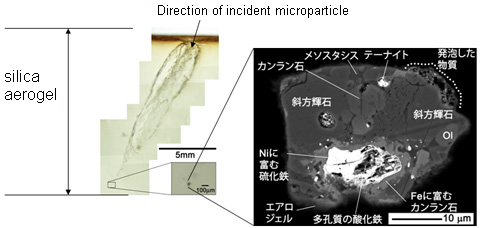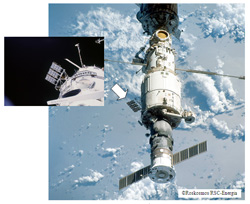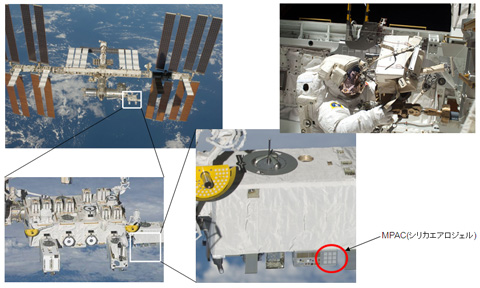This is an archive of information released in the past.
Disclaimer: It may contain broken links or outdated information. Some parts may not function in current web browsers.
*Visit https://humans-in-space.jaxa.jp/en/ for the latest information.

Experiment
- News
- Kibo Utilization Strategy
- Kibo Utilization Plan
- List of JAXA's Utilization Themes
- Experiment Facilities
- Space Environment Utilization
- Archive
The world's first discovered extraterrestrial material captured from the ISS

The Micro-Particles Capturer and Space-Environment Exposure Device (MPAC&SEED); payloads developed by JAXA, which were installed on the exposed portion of Zvezda (a part of the Russian segment) of the International Space Station (ISS), has been found to have captured a new extraterrestrial material with unprecedented mineralogical characteristics. The material has been named "Hoshi."*1
Finding a material with unprecedented structure and mineralogical composition having genetic relation with the interplanetary dust particles*2 and micrometeorites*3 is the world's first discovery.
The finding suggests that the other unknown primordial extraterrestrial materials exist; and it will help us to elucidate what happened during the early stage after the birth of the solar system.
The result was published in the journal "Earth and Planetary Science Letters" in 2011. It also will be presented at the annual meeting of the Japan Association of Mineralogical Sciences (JAMS).
※1 "Hoshi" means "star" in Japanese. It was captured at the exposed portion of Zvezda, which means "star" in Russian.
※2 Extraterrestrial microparticles collected by flying a special airship in the stratosphere. The microparticles are thought to be comet or asteroid originated.
※3 Extraterrestrial microparticles obtained by a process of percolation of Antarctic ice or snow, most of which are considered to be asteroid dusts.

Optical photomicrograph of a silica aerogel (cross-sectional image) and enlarged Hoshi image (cross-sectional, electron microscope image)
(Credit: Earth and Planetary Science Letters 309 (2011) 198-206)

MPAC&SEED installed on the exposed portion of Zvezda. As of April, 2002 (Credit: JAXA)

A set of MPAC and SEED experiment payloads (Credit: JAXA)
The MPAC&SEED comprises two payloads, Micro-Particles Capturer (MPAC) and Space-Environment Exposure Device (SEED).
MPAC aims to capture space debris and micrometeoroids which are becoming concerns these years and to understand their origins and the location and distribution. SEED intends to assess the materials for spacecrafts and to clarify the degradation mechanism to be used under the exposed environment in space.
MPAC&SEED was installed on the exposed portion of Zvezda of the ISS in 2001. Three panels retrieved from 2002 to 2005 have been analyzed from various points of view.
Among these, under the collaborative research with Professor Takaaki Noguchi of Ibaraki University, we have found a micrometeoroid with 30 micrometer in size, captured in silica aerogel*4 of the one returned to Earth in 2005, was found to be a chondrule-like material*5, yet to have novel mineralogical characteristics*6 not found from any other known chondrules.
We have also found that, the oxygen isotope ratio *7 of the ore (olivine and pyroxene) included in "Hoshi" is similar to those of interplanetary dust, micrometeorites, and the dust obtained on ground and in atmosphere and samples from the comet 81P/Wild (Wild 2)*8.
※4 Translucent solid material with a very low density (0.03g/cm)3 is able to capture microparticles without damaging its characteristics.
※5 Chondrules are round grains found in meteorites and thought to hold much information of the early stage after the birth of the solar system. They have a distinctive granular structure not seen on rocks on the ground, are called chondrule-like particles.
※6 Iron sulfide contained in Hoshi is rich in nickel showed that its homogeneous, rich-in nickel facies was not exsolved (the process in which a solution of materials separate into its two or more constituents at a certain temperature.) It meant that it had never been heated more than 100 degrees C after homogenized with more than 900 degrees C. Chondrules including such iron sulfide have never been discovered.
※7 Oxygen has three kinds of stable isotopes 16O, 17O, and 18O. Isotope ratio of oxygen is considered to be different by each planet of the solar system. Extraterrestrial material capture was conducted from 1986 to 1996 on the Russian Mir Space Station; however, measurement of the oxygen isotope ratio was not performed.
※8 Sample dusts captured and returned by the NASA Stardust spacecraft.
There is no material having the both characteristics discovered so far. In other words, Hoshi is thought to be somewhat of a small body originated one, which is different with the known extraterrestrial materials.
On one hand, interplanetary dusts and micrometeorites don't have similar mineralogical characteristics with Hoshi might be caused by the breakup or erosion while passing through atmosphere or on ground.
This suggests that the ISS is the precious place that enables us to obtain extraterrestrial materials without changing the condition.
Next generation MPAC&SEED (as one of the SEDA-AP payload) was installed on the Exposed Facility (EF) of Kibo, and the sample was returned to Earth in 2010. Microparticles captured in silica aerogel are being analyzed and a new discovery is expected.
See also:*All times are Japan Standard Time (JST)
| Copyright 2007 Japan Aerospace Exploration Agency | Site Policy |
